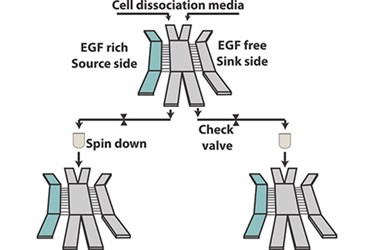New Microfluidic Device Identifies And Isolates Metastatic Cancer Cells
By Joel Lindsey

Researchers at Cornell University have created a new device that they say could effectively and accurately isolate cancer cells most likely to metastasize.
“The approach we’ve taken is a reverse approach from what is conventionally done,” Cynthia Reinhart-King, associate professor of biomedical engineering and researcher on the project, said in a press release published recently on Cornell’s website. “Instead of looking at what molecules are being expressed by the tumor, we’re looking for the phenotype — that is, the behavior — of individual cells first. Then we can determine what molecules are causing that behavior.”
In most attempts to identify highly aggressive cancer cells, the focus is on searching for particular molecules or genes that indicate metastasis. This task often becomes difficult given the subtle differences between cells in the tiny subpopulations of aggressive cancer cells, according to Cornell’s article.
Attempting to avoid this difficulty, researchers involved with this newest project have devised a special microfluidic device that contains a number of side channels designed to wash out the less aggressive cells, while the more aggressive ones are “herded” into their own specific channel.
The device could enable scientists to accurately identify the most aggressive cancer cells while also making it possible for them to better study the specific behaviors and molecular compositions of those cells most likely to metastasize.
“The thing we’re most excited about, in addition to the physical device, is the conceptual framework we’re using by trying to shift gears and screen for cells that are causing the worst parts of the disease,” said Reinhart-King.
In early tests of the microfluidic device, researchers focused on screening for cells with migratory responses to Epidermal Growth Factor. The receptor responsible for such responses is present in most human cancer cells and is closely connected to poor prognosis, making it a good candidate for testing the effectiveness of the device.
Outcomes of early tests and details regarding the new device have been published recently in the journal Technology.
While the microfluidic device has been designed for screening and studying cancer cells, Reinhart-King says it could also prove beneficial in other applications such as tissue engineering and as an aid in healing wounds.
Image Credit: Reinhart-King lab
